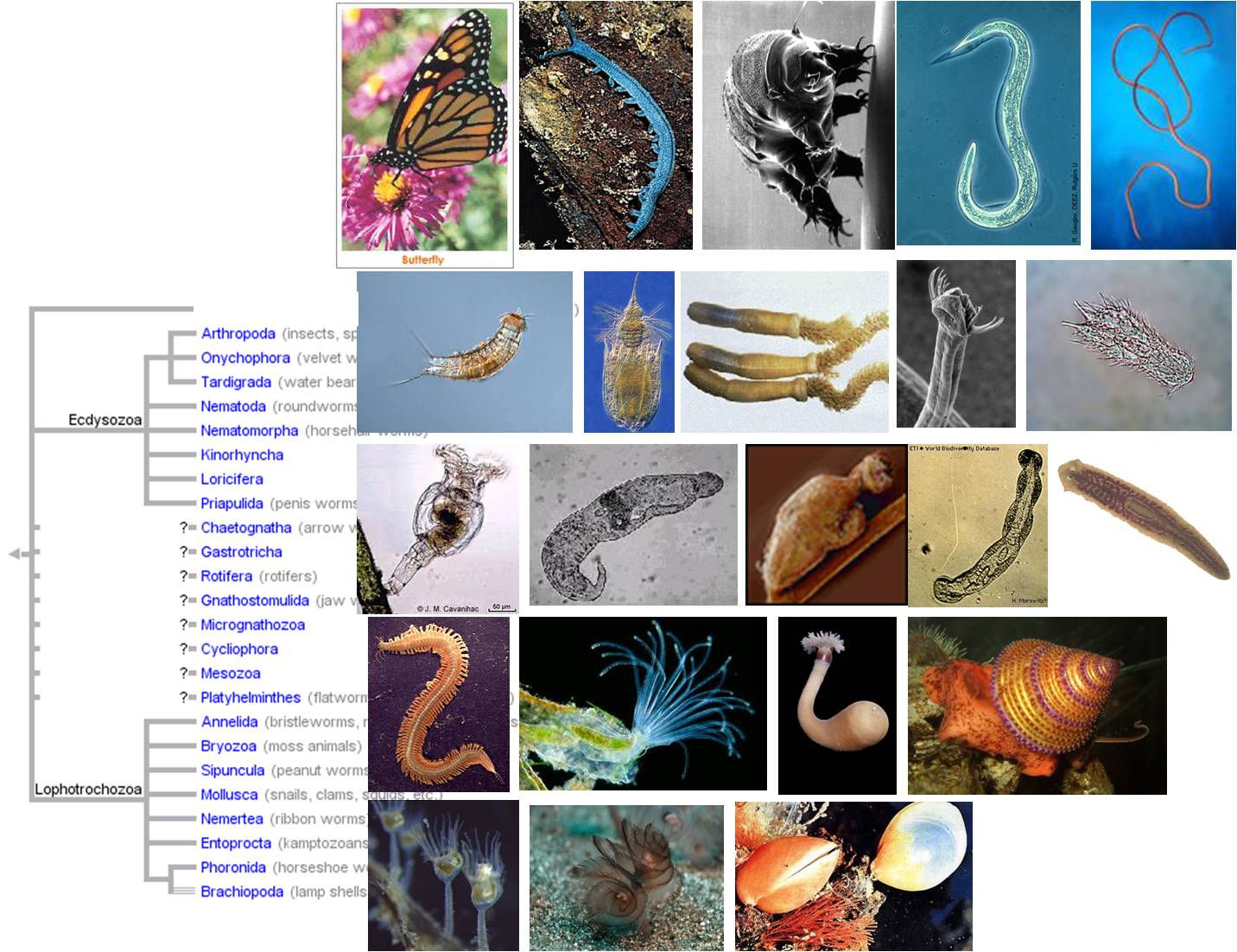 The
Diversity of Life
The
Diversity of Life  The
Diversity of Life
The
Diversity of Life 1. Overview:
The other major opisthokont group is the Animalia. Animals are distinguished as multicellular, heterotrophic eukaryotes that lack a cell wall. Obviously, the lack of a cell wall distinguishes them from the other multicelluar, heterotropic eukaryotes - the fungi. There is genetic and morphological evidence that animals evolved from choanoflagellate ancestors - probably between 900-700 mya. The oldest animal fossils unearthed to date were found in Australia, in August 2010. They are thought to be sponges, and they date to 650 mya. Sponges are the most 'primitive' group of animals, with the most direct ties to the choanoflagellates, so their early appearance in the fossil record corroborates phylogenetic hypotheses.
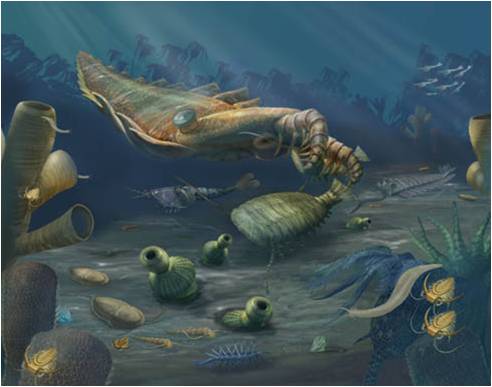 Animal
fossils become much more abundant in the fossil record 550 mya. Although there
are older fossils of soft -bodied jellyfish and worms, the fossil record seems
to 'explode' about 550 mya - an observation that led early Paleotologists to
demarcate this as the beginning of the Paleozoic Era. This explosion probably
occurred because some animals - notably arthropods and molluscs - evolved a
protective body covering (exoskeleton or shell, respectively) that protected
them against the stinging cnidarian predators. The radiation of these groups
left a disproportionate mark on the fossil record because hard parts fossilize
much more readily than soft tissue. So, in part, the 'Cambrian Explosion' is
probably due to sampling bias - organisms evolved that were more likely to fossilize,
so we see more fossils. The evolution of arthropods in the Cambrian led to an
explosion of diversity that is still occurring today - over 85% of the animal
species named to date are Arthropods. In the figure to the right, we see an
artists depiction of the Cambrian Period, with a variety of sponges, cnidarians,
molluscs, and arthropods, including the large predatory arthropod, Anomalocaris
- that grasped other animals with its raptorial claws and crushed them in their
circular jaws.
Animal
fossils become much more abundant in the fossil record 550 mya. Although there
are older fossils of soft -bodied jellyfish and worms, the fossil record seems
to 'explode' about 550 mya - an observation that led early Paleotologists to
demarcate this as the beginning of the Paleozoic Era. This explosion probably
occurred because some animals - notably arthropods and molluscs - evolved a
protective body covering (exoskeleton or shell, respectively) that protected
them against the stinging cnidarian predators. The radiation of these groups
left a disproportionate mark on the fossil record because hard parts fossilize
much more readily than soft tissue. So, in part, the 'Cambrian Explosion' is
probably due to sampling bias - organisms evolved that were more likely to fossilize,
so we see more fossils. The evolution of arthropods in the Cambrian led to an
explosion of diversity that is still occurring today - over 85% of the animal
species named to date are Arthropods. In the figure to the right, we see an
artists depiction of the Cambrian Period, with a variety of sponges, cnidarians,
molluscs, and arthropods, including the large predatory arthropod, Anomalocaris
- that grasped other animals with its raptorial claws and crushed them in their
circular jaws.
Animals are a fairly recent addition to the living world. They are not very genetically or metabolically diverse when compared to prokaryotes or protists that have much longer evolutionary histories. However, animals are structurally diverse. They have radiated into a wide variety of shapes through changes in developmental patterning. These different shapes have allowed them to exploit a wide range of habitats and resources. Animals are classified into phyla based on their shape or body plan. As heterotrophs, these differences often correlate with differences in feeding structures or locomotory structures that they use to capture food.
From our vantage point as large terrestrial organisms, we have a very skewed view of animal diversity. This is represented by our casual division of animals into 'vertebrates' (like us) and 'invertebrates' (other stuff not like us). These are not phylogenetic groups. The Vertebrata is one sub-phylum of the phylum Chordata, which is one of 32 phyla of animals. The two other sub-phyla of Chordates, and all the other 31 phyla, are 'invertebrate' - and they obviously represent the bulk of animal diversity. Indeed, 95% of all animal species are 'invertebrates', with 85%, as mentioned, occurring in the single phylum Arthropoda. In addition, most animal phyla are exclusively marine - so we rarely encounter them. As you look through the groups pictured at the top of the page (the protostome phyla), you'll see that most animals are rather simple, bilaterally symmetrical, worm-like organisms with different feeding structures.
We are only going to consider the major phyla of animals here, those representing important evolutionary innovations in the group, or representing important radiations.
2. Development
 One
of the defining features in the animals is their method of early embryonic development.
The subsequent differences that develop in shape occur after these initial stages
take place. The union of sperm and egg form a diploid zygote. the zygote divides
by mitosis, forming a solid ball of cells called the morula. The cells in the
morula migrate, moving out from under other cells until they form a hollow ball
of cells called the blastula. Then, one side of the blastula migrates in towards
the center of the embryo. This process of infolding, or invagination, creates
the gastrula. The gastrula has two layers of cells: one layer is on the outside
(ectoderm) and the other (endoderm) is on the inside, lining the newly-formed
cavity the infolding produced. This cavity becomes the gut in all animals. The
hole that connects the gut with the environment becomes either the mouth or
anus of the mature animal. Although sponge development is slight different,
they still form these typical stages. In all other animals, from cnidarians
to cats, the process is fundamentally the same. Differences in shape emerge
as the embryo developes from this gastrula.
One
of the defining features in the animals is their method of early embryonic development.
The subsequent differences that develop in shape occur after these initial stages
take place. The union of sperm and egg form a diploid zygote. the zygote divides
by mitosis, forming a solid ball of cells called the morula. The cells in the
morula migrate, moving out from under other cells until they form a hollow ball
of cells called the blastula. Then, one side of the blastula migrates in towards
the center of the embryo. This process of infolding, or invagination, creates
the gastrula. The gastrula has two layers of cells: one layer is on the outside
(ectoderm) and the other (endoderm) is on the inside, lining the newly-formed
cavity the infolding produced. This cavity becomes the gut in all animals. The
hole that connects the gut with the environment becomes either the mouth or
anus of the mature animal. Although sponge development is slight different,
they still form these typical stages. In all other animals, from cnidarians
to cats, the process is fundamentally the same. Differences in shape emerge
as the embryo developes from this gastrula.
3. Body Plans
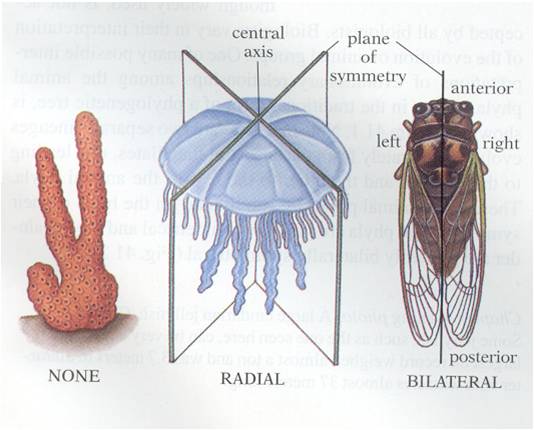 Animals
exibit a wide range of shapes, but these shapes can be classified in three major
groups. First, the sponges are asymmetrical. Second, the cnidarians and ctenophores
are 'radially symmetrical. This means that, if you are looking down on the organism
from the top, you could cut the organism is half along any axis passing through
the midpoint and the two halves would be be the same. The rest of the animals
are bilaterally symmetrical. This means that there is only one plane of division
that will create to symmetrical 'sides' (bi-lateral = two sides). Given the
fact that the vast majority of animal phyla are bilaterally symmetrical, we
can hypothesize that this evolutionary innovation was functionally important
- allowing animals to work "better", somehow. But how?
Animals
exibit a wide range of shapes, but these shapes can be classified in three major
groups. First, the sponges are asymmetrical. Second, the cnidarians and ctenophores
are 'radially symmetrical. This means that, if you are looking down on the organism
from the top, you could cut the organism is half along any axis passing through
the midpoint and the two halves would be be the same. The rest of the animals
are bilaterally symmetrical. This means that there is only one plane of division
that will create to symmetrical 'sides' (bi-lateral = two sides). Given the
fact that the vast majority of animal phyla are bilaterally symmetrical, we
can hypothesize that this evolutionary innovation was functionally important
- allowing animals to work "better", somehow. But how?
Bilateral symmetry does more than create two sides; it also means that there is a top and bottom, and a front and back. As heterotrophs, most animals have to moving through the environment in search for their food. Having a 'front' would favor the concentration of sensory systems at this end - so that the animal could perceive the environment that it was about to enter and search for food and avoid predators. So, bilateral symmetry is associated with the formation of a head and the evolution of a brain for processing all this sensory information and directing locomotion. It is no coincidence, therefore, that bilateral symmetry allowed some animals to "get a-head". hahaha.
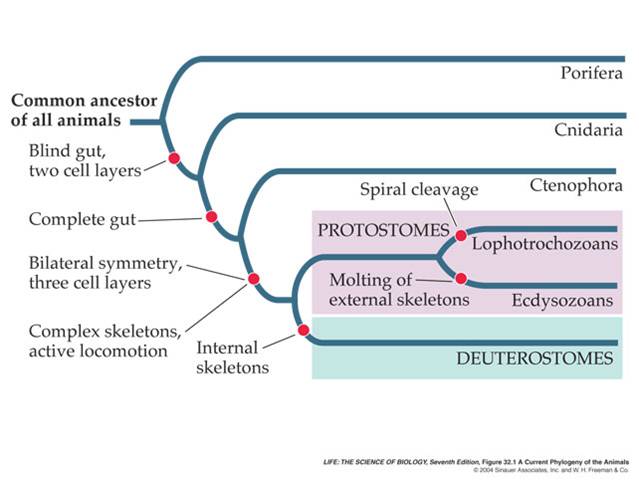 4.
Phylogeny
4.
Phylogeny
These developmental patterns are reflected by animal phylogeny. Sponges are the simplest animals; they retain the collar cells (choanocytes) that are so similar to the choanoflagellates, and the cells in sponges do not form true tissue layers (where the cells are bound together in a matrix of secreted proteins). The remaining animals are distinguished by having only two true tissues (ecto and endoderm) or three (with mesoderm). In addition, the more primitive animals are radially symmetrical, while the animals with three tissue layers are bilaterally symmetrical. These bilateral animals are grouped by whether the blastopore forms the mouth ('protostomes') or anus ('deuterostomes'). The protostomes are further classified by how their larvae develop or how they grow: lophotrochozoans have particualr larval stages and grow by adding segments in some cases, whereas the ecdysozoans have a cuticle/exoskeleton and must shed this in order to grow. We will review these patterns as we move through the major animal phyla.
5. Major Phyla
a. Phylum Porifera: Sponges
 Sponges
consist of specialized but loosely integrated cells; the cells are not
anchored in a layer of protein (known as a basement membrane) as in
other animals. So, curiously, some sponges can be 'disintegrated' in a blender
and will then re-assemble into many small sponges, with cell types reintegrating
into their appropriate relationship. These aggregates are asymmetrical, but
the fundamental filtering unit is often vase-like. The cells in a vase unit
form two layers; the inside layer consists of choanocytes that are very similar
to free-living choanoflagellates. The beating of the flagella create a current
that pulls water through pore cells into the central chamber of the sponge -
water exits through the top hole or 'osculum'. The choanocytes feed by ingesting
organic material by phagocytosis. The outer cell layer is the 'epidermis'. The
epidermis receives nutrients from the choanocytes in an interesting way: the
food that is absorbed by the inner layer of choanocytes is passed to amoebocytes
- motile cells that live in the space between the cell layers. This space, the
mesohyl, contains flexible spongin proteins, and may contain rigid spicules
of silca. The ameobocyte crawls back and forth, transferring food from the chaoanocytes
to the epidermal cells. Sponges are filter feeders. They reproduce asexually
by fragmentation (pieces can break off and settle elsewhere), and by sexual
reproduction.
Sponges
consist of specialized but loosely integrated cells; the cells are not
anchored in a layer of protein (known as a basement membrane) as in
other animals. So, curiously, some sponges can be 'disintegrated' in a blender
and will then re-assemble into many small sponges, with cell types reintegrating
into their appropriate relationship. These aggregates are asymmetrical, but
the fundamental filtering unit is often vase-like. The cells in a vase unit
form two layers; the inside layer consists of choanocytes that are very similar
to free-living choanoflagellates. The beating of the flagella create a current
that pulls water through pore cells into the central chamber of the sponge -
water exits through the top hole or 'osculum'. The choanocytes feed by ingesting
organic material by phagocytosis. The outer cell layer is the 'epidermis'. The
epidermis receives nutrients from the choanocytes in an interesting way: the
food that is absorbed by the inner layer of choanocytes is passed to amoebocytes
- motile cells that live in the space between the cell layers. This space, the
mesohyl, contains flexible spongin proteins, and may contain rigid spicules
of silca. The ameobocyte crawls back and forth, transferring food from the chaoanocytes
to the epidermal cells. Sponges are filter feeders. They reproduce asexually
by fragmentation (pieces can break off and settle elsewhere), and by sexual
reproduction.
b. Phylum Cnidaria: Hydra, anemones, corals, jellyfish
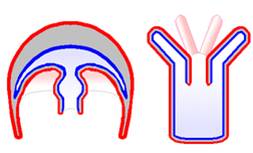 Although
the cnidarians may seem to be quite different from one another, the body plans
of jellyfish ('medusa' plan) and anemones ('polyp' plan) are actually very similar.
All cnidarians have a rather simple plan of two true tissue layers separated
by a gel/protein filled space (mesoglea). The outer layer covers the tentacles,
which have cnidocytes. These are cells that house a harpoon-like structure.
Any bump or brush and the harpoon is deployed, along with toxins that paralyze
the prey. The tentacles contract and draw the prey into the gut cavity, where
extracellular digestion occurs. Emzymes are produced by endodermal tissue and
these enzymes are secreted into the gut cavity. The products of this digestion
are absorbed by cells by phagocytosis, so there is both intra and extracellular
digestion. As in sponges, there are ameobocytes that transfer nutrients from
the endodermis to the ectodermis. The inner cell layer, the endoderm, lines
the gut cavity. In cnidarians, digestion is both extracellular and intracellular.
Cnidarians have a 'nerve net' - a decentralized organization of nerve-like cells
that coordinate the movement of tentacles. Some cnidarians are exclusively asexual,
but most can reproduce sexually.
Although
the cnidarians may seem to be quite different from one another, the body plans
of jellyfish ('medusa' plan) and anemones ('polyp' plan) are actually very similar.
All cnidarians have a rather simple plan of two true tissue layers separated
by a gel/protein filled space (mesoglea). The outer layer covers the tentacles,
which have cnidocytes. These are cells that house a harpoon-like structure.
Any bump or brush and the harpoon is deployed, along with toxins that paralyze
the prey. The tentacles contract and draw the prey into the gut cavity, where
extracellular digestion occurs. Emzymes are produced by endodermal tissue and
these enzymes are secreted into the gut cavity. The products of this digestion
are absorbed by cells by phagocytosis, so there is both intra and extracellular
digestion. As in sponges, there are ameobocytes that transfer nutrients from
the endodermis to the ectodermis. The inner cell layer, the endoderm, lines
the gut cavity. In cnidarians, digestion is both extracellular and intracellular.
Cnidarians have a 'nerve net' - a decentralized organization of nerve-like cells
that coordinate the movement of tentacles. Some cnidarians are exclusively asexual,
but most can reproduce sexually.
The "Bilateria"
The remaining animal phyla are bilaterally symmetrical organisms. Their symmetry is encoded by Hox genes that establish the anterior-posterior axis of the body. As mentioned above, bilateral symmetry is advantageous because it establishes a polarity to the animal - and sense systems and neaural integration can be concentrated at the anterior end.
The bilaterally symmetrical animals have three true tissue layers (triploblastic), adding mesoderm to endo- and ectoderm. Tehy form two major clades, distinguished by whether the blastopore developes into the mouth (Protostomes) or the anus (Deuterostomes) in the adult. The protostomes are further divided by other developmental characteristics. One major clade, the Ecdysozoa, must shed a hard cuticle or exoskeleton in order to grow. The other clade, the Lophotrochozoans, is distinguished by having either a rake-like feeding apparatus ('lophophore' - seen in some of the pictures in the lower two rows, above), or a specific larval stage known as a 'trochophore'. As you can see from the phylogeny above, there are many groups whose phylogenic relationships are unknown at this time.
Protostomes: Lophotrochozoans
c. Phylum Platyhelminthes: Flatworms
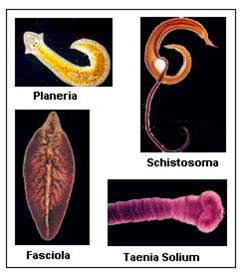 The
flatworms are a rather primitive group of bilaterally symmetrical organisms
that maintain some of the basic characteristics of cnidarians. Like cnidarians,
they have a digestive cavity with only one opening; they do not have a one-way
digestive tract. However, the gut of flatworms is highly bifurcated and convoluted,
with pockets that radiate out into the deep tissue on the sides of the animal.
This is probably adaptive in this organism because it insures that no cell is
too far from the gut (and digested nutrients). Flatworms also have ameobocytes
like sponges and cnidarians, too; these transport nutrients between the endodermal
cells lining the gut and the rest of the tissues in the animal. Digestion is
both intracellular and extracellular, as in cnidarians. The major evolutionary
innovations in this group are associated with bilaterality. The nervous system
and sensory organs (eyespots and chemoreceptive auricles) are concentrated towards
the anterior end of the animal, creating a head (of sorts). Flatworms are a
diverse group, with free-living and parasitic forms. Planaria live in marine,
freshwater, and terrestrial environments. Flukes are parasitic, like the liver
flukes and blood flukes (Schistosomes) we saw in lab. Most of these species
have at least one intermediate host and a complex life cycle. At some point
in the life cycle there is usually an asexual stage in which thousands of offspring
can be produced asexually. This is particularly important for parasites that
infect different hosts in sequence, because the probability of finding new hosts
is low. Tapeworms are another group of parastic flatworms. Over 1000 species
have been described, and every vertebrate species is infected by at least one
species of tapeworm. Humans are infected by three, with sheep, pigs, cattle,
and fish acting as intermediate hosts. Tapeworms are weird. Humans ingest living
cysts in undercooked beef, lamb, pork, and fish. The immature worm hatches from
the cysts and attached to the wall of the intestine with the hooks on the scolex
- the head segment. As the worm matures and grows, it produces body segments
called proglottids. Each proglottid contains male and female reproductive organs.
As the worm creates new proglottids behind the head, older proglottids that
are farther from the head mature. The worm can be over 12m long in humans; some
grow to over 30m in length! Each proglottid is metabolically independent, absorbing
nutrients by diffusion, directly from the hosts intestinal tract. The high SA/V
ratio of these flatworms aids in this parasitic lifestyle. Each proglottid produces
egg and sperm; sperm are received by proglottids and the development of fertilized
eggs occurs in each proglottid. Eventually, the mature proglottids are shed
by the worm, and are shed from the host in feces. The proglottids are eaten
by the secondary host (sheep, pigs, cattle, and fish). The larvae hatch, bore
through the intestinal wall, and migrate to muscle tissue where they encyst.
Consumption of undercooked meat by another person completes the life cycle.
The
flatworms are a rather primitive group of bilaterally symmetrical organisms
that maintain some of the basic characteristics of cnidarians. Like cnidarians,
they have a digestive cavity with only one opening; they do not have a one-way
digestive tract. However, the gut of flatworms is highly bifurcated and convoluted,
with pockets that radiate out into the deep tissue on the sides of the animal.
This is probably adaptive in this organism because it insures that no cell is
too far from the gut (and digested nutrients). Flatworms also have ameobocytes
like sponges and cnidarians, too; these transport nutrients between the endodermal
cells lining the gut and the rest of the tissues in the animal. Digestion is
both intracellular and extracellular, as in cnidarians. The major evolutionary
innovations in this group are associated with bilaterality. The nervous system
and sensory organs (eyespots and chemoreceptive auricles) are concentrated towards
the anterior end of the animal, creating a head (of sorts). Flatworms are a
diverse group, with free-living and parasitic forms. Planaria live in marine,
freshwater, and terrestrial environments. Flukes are parasitic, like the liver
flukes and blood flukes (Schistosomes) we saw in lab. Most of these species
have at least one intermediate host and a complex life cycle. At some point
in the life cycle there is usually an asexual stage in which thousands of offspring
can be produced asexually. This is particularly important for parasites that
infect different hosts in sequence, because the probability of finding new hosts
is low. Tapeworms are another group of parastic flatworms. Over 1000 species
have been described, and every vertebrate species is infected by at least one
species of tapeworm. Humans are infected by three, with sheep, pigs, cattle,
and fish acting as intermediate hosts. Tapeworms are weird. Humans ingest living
cysts in undercooked beef, lamb, pork, and fish. The immature worm hatches from
the cysts and attached to the wall of the intestine with the hooks on the scolex
- the head segment. As the worm matures and grows, it produces body segments
called proglottids. Each proglottid contains male and female reproductive organs.
As the worm creates new proglottids behind the head, older proglottids that
are farther from the head mature. The worm can be over 12m long in humans; some
grow to over 30m in length! Each proglottid is metabolically independent, absorbing
nutrients by diffusion, directly from the hosts intestinal tract. The high SA/V
ratio of these flatworms aids in this parasitic lifestyle. Each proglottid produces
egg and sperm; sperm are received by proglottids and the development of fertilized
eggs occurs in each proglottid. Eventually, the mature proglottids are shed
by the worm, and are shed from the host in feces. The proglottids are eaten
by the secondary host (sheep, pigs, cattle, and fish). The larvae hatch, bore
through the intestinal wall, and migrate to muscle tissue where they encyst.
Consumption of undercooked meat by another person completes the life cycle.
d. Phylum Annelida: Segmented worms
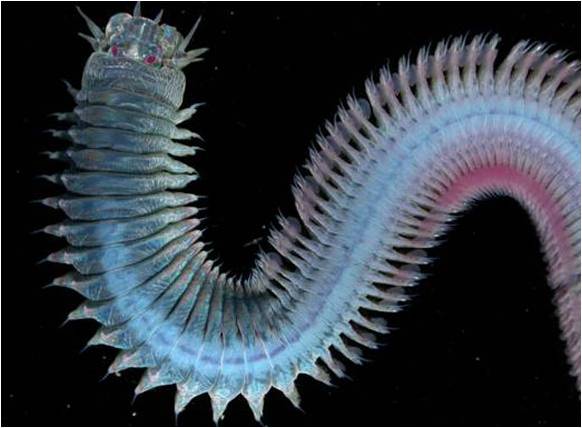 Annelids
include three major groups - the polychaete worms (like we used in lab as the
outgroup for assessing shared derived traits in arthropods), earthworms (like
we dissected in lab), and leeches. Annelids inhabit marine, freshwater, and
terrestrial environments. The annelids are an ancient group, but their soft
bodies do not fossilize well. However, there are unambiguous annelids that date
to the Cambrian, and the putative polychaete Dicksonia dates from the
Vendian Period 600 mya. With the Annelida we see a fundamental change in body
plan - segmentation. Like gene duplication, the replication of body units into
separate segments easily allows for body region to specialize, or to evolve
a new function in one area without compromising the ability to perform original
functions in other segments. This redundancy is easily seen in the anterior
region of earthworms, where each segment contains a heart. Likewise, each segment
throughout the animal contains its own excretory units - nephridia. Each segment
of polychaetes has parapodia - 'side-feet' used for locomotion and respiration
(increasing the surface area for gas exchange). Annelids have a true body cavity,
they are not solid cells from the gut to the outer wall. This cavity provides
room for outpocketings of the digestive tract and other organs. In addition,
this fluid-
Annelids
include three major groups - the polychaete worms (like we used in lab as the
outgroup for assessing shared derived traits in arthropods), earthworms (like
we dissected in lab), and leeches. Annelids inhabit marine, freshwater, and
terrestrial environments. The annelids are an ancient group, but their soft
bodies do not fossilize well. However, there are unambiguous annelids that date
to the Cambrian, and the putative polychaete Dicksonia dates from the
Vendian Period 600 mya. With the Annelida we see a fundamental change in body
plan - segmentation. Like gene duplication, the replication of body units into
separate segments easily allows for body region to specialize, or to evolve
a new function in one area without compromising the ability to perform original
functions in other segments. This redundancy is easily seen in the anterior
region of earthworms, where each segment contains a heart. Likewise, each segment
throughout the animal contains its own excretory units - nephridia. Each segment
of polychaetes has parapodia - 'side-feet' used for locomotion and respiration
(increasing the surface area for gas exchange). Annelids have a true body cavity,
they are not solid cells from the gut to the outer wall. This cavity provides
room for outpocketings of the digestive tract and other organs. In addition,
this fluid-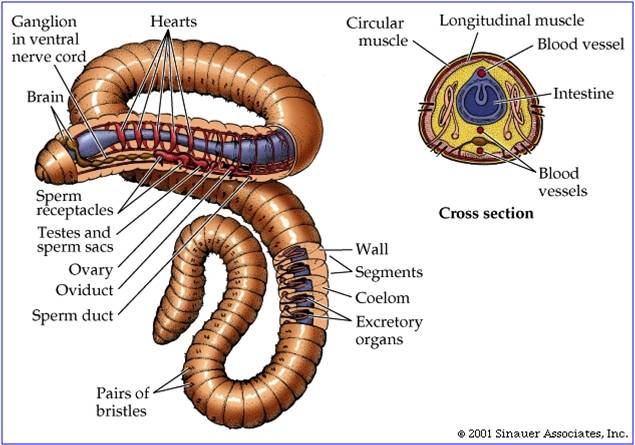 filled
space can act as a hydrostatic skeleton that allows for refined, peristaltic
locomotion. Water is incompressible, so muscles contracting in one part of the
body push the water in the coelom somewhere else, like towards the front of
the animal which extends the body forward. Annelids also have another important
difference with the other phyla we have considered - they have a digestive tract
rather than a gut cavity. In a gut cavity, new food is added and is mixed with
digesting food; there is no separation and so there can be no specialization
of digestive function. In a tract, where food enters at one end of the animal
(mouth) and passes in one direction towards the exit (anus), there can be specialization
of function along the route - creating a "dis-assembly line" that
breaks food down and harvests energy more efficiently. We see this specialization
in earthworms, where the mucular pharynx contracts to extend the mouth for ingestion,
the crop that stores food and delivers it evenly to the gizzard, which grinds
the food into smaller particles (increasing its surface area for the action
of enzymes), and the intestine where digestion and the absorption of nutrients
occurs. Earthworms eat soil, digesting the fungi, bacteria, organic molecules
and protists. They pass fecal pellets that contain the mineral components and
unabsorbed organics. By creating these pellets, they improve the ability of
water and air to travel through the soil, increasing the uptake of water and
soluble nutrients, and increasing gas exchange by plant roots. This increases
the growth rate of plants and increases the productivity of the community.
filled
space can act as a hydrostatic skeleton that allows for refined, peristaltic
locomotion. Water is incompressible, so muscles contracting in one part of the
body push the water in the coelom somewhere else, like towards the front of
the animal which extends the body forward. Annelids also have another important
difference with the other phyla we have considered - they have a digestive tract
rather than a gut cavity. In a gut cavity, new food is added and is mixed with
digesting food; there is no separation and so there can be no specialization
of digestive function. In a tract, where food enters at one end of the animal
(mouth) and passes in one direction towards the exit (anus), there can be specialization
of function along the route - creating a "dis-assembly line" that
breaks food down and harvests energy more efficiently. We see this specialization
in earthworms, where the mucular pharynx contracts to extend the mouth for ingestion,
the crop that stores food and delivers it evenly to the gizzard, which grinds
the food into smaller particles (increasing its surface area for the action
of enzymes), and the intestine where digestion and the absorption of nutrients
occurs. Earthworms eat soil, digesting the fungi, bacteria, organic molecules
and protists. They pass fecal pellets that contain the mineral components and
unabsorbed organics. By creating these pellets, they improve the ability of
water and air to travel through the soil, increasing the uptake of water and
soluble nutrients, and increasing gas exchange by plant roots. This increases
the growth rate of plants and increases the productivity of the community.
e. Phylum Mollusca: Chitons, Bivalves, Snails, and Cephalopods
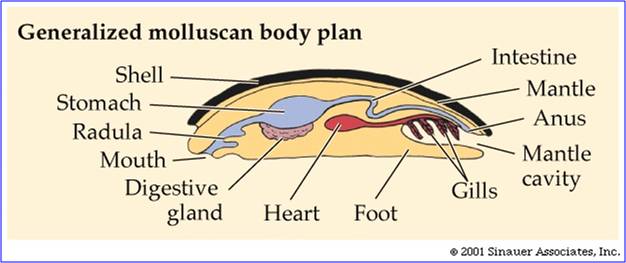 The
molluscs are also an ancient group, dating to the late pre-Cambrian Period (about
560 mya). Shelled molluscs, protected from cnidarian predators, radiate in the
Cambrian. The molluscan body plan is fairly simple, best seen in the most primitive
extant lineage, the Polyplacophorans (Chitons). They are bilaterally symmetrical
with a complete digestive tract. Their body is covered by a hood-like structure
called the mantle. This mantle creates a pocket between the body of the animal
and the hood. Gills are present in this mantle cavity. The bottom of the animal
is a muscular foot. In many molluscs, the mantle secretes a shell. In the polyplacophorans,
the shell is composed of 8 units or plates, suggesting the segmented ancestry
of the group. However, more derived molluscs have lost most indications of segmentation.
Although molluscs take a wide variety of shapes, from snails to clams to squid,
all of these shapes are just variations on this basic theme.
The
molluscs are also an ancient group, dating to the late pre-Cambrian Period (about
560 mya). Shelled molluscs, protected from cnidarian predators, radiate in the
Cambrian. The molluscan body plan is fairly simple, best seen in the most primitive
extant lineage, the Polyplacophorans (Chitons). They are bilaterally symmetrical
with a complete digestive tract. Their body is covered by a hood-like structure
called the mantle. This mantle creates a pocket between the body of the animal
and the hood. Gills are present in this mantle cavity. The bottom of the animal
is a muscular foot. In many molluscs, the mantle secretes a shell. In the polyplacophorans,
the shell is composed of 8 units or plates, suggesting the segmented ancestry
of the group. However, more derived molluscs have lost most indications of segmentation.
Although molluscs take a wide variety of shapes, from snails to clams to squid,
all of these shapes are just variations on this basic theme.
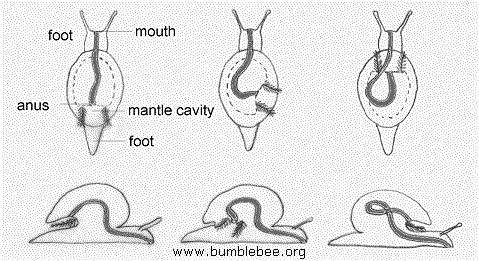 Snails
have put a 'twist' on molluscan evolution. The shell and mantle rotate during
development, placing the mantle cavity at the back of the animal. Many snails
are grazers; they scrape algae off rocks with a file-like tongue called a radula.There
are many predatory snails, however. Oyster drills have a tough radula, and they
scrape a hole through oyster shells. They then extend their proboscis through
the hole and consume the oyster. Coneshells, in the genus Conus, have
a modified radula that takes the shape and function of a harpoon. They stab
fish and inject a potent toxin; some Conus snail toxins are also lethal
to humans. Almost all molluscs are marine or aquatic; only some snails have
colonized land.The most coloful molluscs are nudibranchs (sea slugs); they prey
on hydroids and coral polyps, and some even prey on venomous jellyfish. Some
species are able to digest the cnidarians without disturbing their cnidocytes,
and these cells are moved to the back of the nudibranch and protect it against
the nudibranch's own predators. The bright colors are though to be warning coloration.
The protuberances on the back are the "branch's" - the external gill-like
respiratory organs.
Snails
have put a 'twist' on molluscan evolution. The shell and mantle rotate during
development, placing the mantle cavity at the back of the animal. Many snails
are grazers; they scrape algae off rocks with a file-like tongue called a radula.There
are many predatory snails, however. Oyster drills have a tough radula, and they
scrape a hole through oyster shells. They then extend their proboscis through
the hole and consume the oyster. Coneshells, in the genus Conus, have
a modified radula that takes the shape and function of a harpoon. They stab
fish and inject a potent toxin; some Conus snail toxins are also lethal
to humans. Almost all molluscs are marine or aquatic; only some snails have
colonized land.The most coloful molluscs are nudibranchs (sea slugs); they prey
on hydroids and coral polyps, and some even prey on venomous jellyfish. Some
species are able to digest the cnidarians without disturbing their cnidocytes,
and these cells are moved to the back of the nudibranch and protect it against
the nudibranch's own predators. The bright colors are though to be warning coloration.
The protuberances on the back are the "branch's" - the external gill-like
respiratory organs.
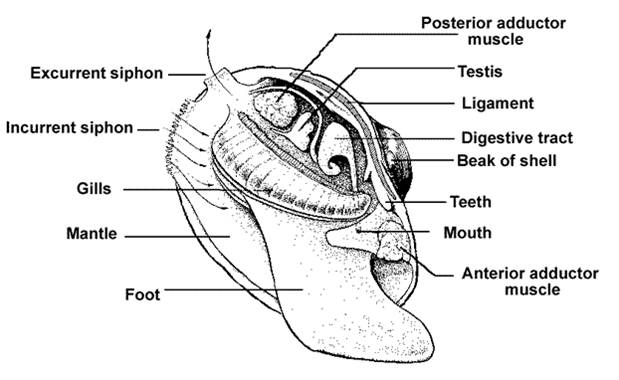 Bivalves
are an unusual group of molluscs. Bivalves are aquatic/marine filter feeders;
they lay on the sediment and filter water between the 'valves' of their shell.
They are bilaterally symmetrical; the midline of their back runs along the hinge
of their shell - so their shell comes down on both sides of the animal, covering
the animal and the foot. However, since the animals are sessile filter feeders,
their nervous system has evolved to be decephalized (decentralized). They don't
have a head - rather, because they do not move, their sensory systems have been
redistributed around the organism so they can perceive their environment from
all directions. Scallops, for instance, have eyes all around the margin of their
mantle and shell. So again, here is a sort of exception that proves the rule:
bilaterality directs a pattern of motion, which selects for cephalization at
one end. Some sessile organisms that don't move through the environment are
decephalized.
Bivalves
are an unusual group of molluscs. Bivalves are aquatic/marine filter feeders;
they lay on the sediment and filter water between the 'valves' of their shell.
They are bilaterally symmetrical; the midline of their back runs along the hinge
of their shell - so their shell comes down on both sides of the animal, covering
the animal and the foot. However, since the animals are sessile filter feeders,
their nervous system has evolved to be decephalized (decentralized). They don't
have a head - rather, because they do not move, their sensory systems have been
redistributed around the organism so they can perceive their environment from
all directions. Scallops, for instance, have eyes all around the margin of their
mantle and shell. So again, here is a sort of exception that proves the rule:
bilaterality directs a pattern of motion, which selects for cephalization at
one end. Some sessile organisms that don't move through the environment are
decephalized.
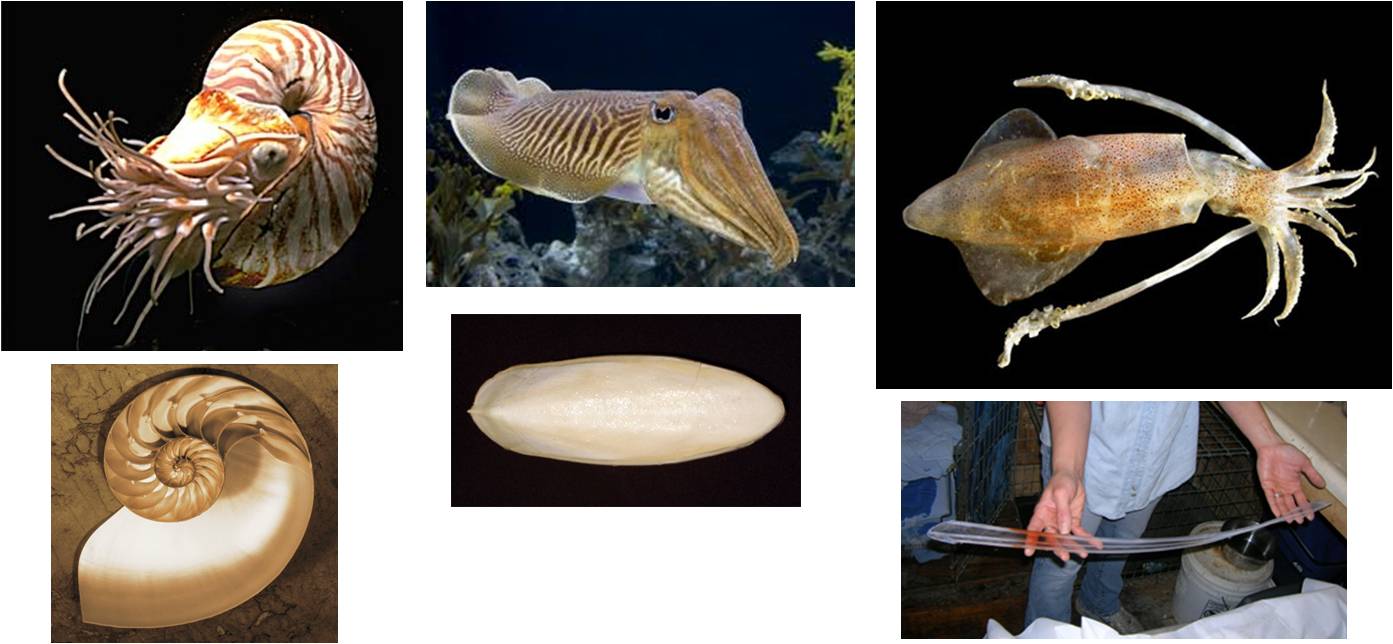 The
last group of molluscs are the other-wordly cephalopods. Although they look
very different from a chiton, the evolution of their body plan entailed a rather
simple modification - the folding of the animal head to tail, and the elongation
of the back. The folding of the animal created an anterior half to the foot,
which evolved into tentacles, and a posterior half to the foot, which evolved
into the siphon. The mantle forms a muscular cowl over the organism, and water
can be sucked into the mantle cavity through the siphon, aerating the gills,
and then expelled by the muscular contraction of the mantle - propelling the
animal in a direction determined by the aiming of the siphon. As their name
implies, the cephalopods have a big head - and it is a brainy, smart head, too.
This correlates with their predatory behavior. As a general rule, predators
are pretty clever animals - at least more clever than their prey. This is especially
true for highly active and mobile predators like cephalopods, cats, and dogs.
Cephalopods are the largest living invertebrates, and they are also generally
regarded as the smartest. They can learn by mimicry. In a famous study, two
octopuses were placed in neighboring glass aquaria that had red and blue balls
at one end. One octopus had been trained to travel to the other end of the aquarium
and pick up a red ball to receive food. After observing this behavior, the second
untrained octopus would travel to the end of its aquarium and pick up a red
ball (not a blue one). That is alot of higher processing occuring. Within the
cephalopods, the evolutionary trend has been the reduction, internalization,
and loss of the shell. A shell is very heavy; reducing its size increases the
mobility of the predator. Internalizing the shell, as a rigid strut ("pen")
in squid allows it to help the hydrodynamics of the organism. For octopus,which
are sit and wait predators, the loss of the shell was adaptive because it meant
that octopus could squeeze into very narrow cavities to escape their predators
and to surprize their prey.
The
last group of molluscs are the other-wordly cephalopods. Although they look
very different from a chiton, the evolution of their body plan entailed a rather
simple modification - the folding of the animal head to tail, and the elongation
of the back. The folding of the animal created an anterior half to the foot,
which evolved into tentacles, and a posterior half to the foot, which evolved
into the siphon. The mantle forms a muscular cowl over the organism, and water
can be sucked into the mantle cavity through the siphon, aerating the gills,
and then expelled by the muscular contraction of the mantle - propelling the
animal in a direction determined by the aiming of the siphon. As their name
implies, the cephalopods have a big head - and it is a brainy, smart head, too.
This correlates with their predatory behavior. As a general rule, predators
are pretty clever animals - at least more clever than their prey. This is especially
true for highly active and mobile predators like cephalopods, cats, and dogs.
Cephalopods are the largest living invertebrates, and they are also generally
regarded as the smartest. They can learn by mimicry. In a famous study, two
octopuses were placed in neighboring glass aquaria that had red and blue balls
at one end. One octopus had been trained to travel to the other end of the aquarium
and pick up a red ball to receive food. After observing this behavior, the second
untrained octopus would travel to the end of its aquarium and pick up a red
ball (not a blue one). That is alot of higher processing occuring. Within the
cephalopods, the evolutionary trend has been the reduction, internalization,
and loss of the shell. A shell is very heavy; reducing its size increases the
mobility of the predator. Internalizing the shell, as a rigid strut ("pen")
in squid allows it to help the hydrodynamics of the organism. For octopus,which
are sit and wait predators, the loss of the shell was adaptive because it meant
that octopus could squeeze into very narrow cavities to escape their predators
and to surprize their prey.
Protostomes: Ecdysozoans
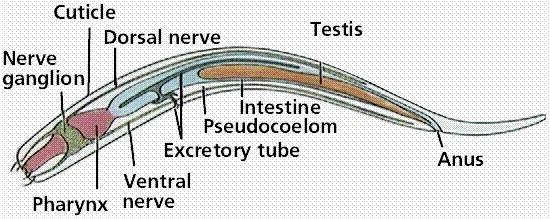 f.
Phylum Nematoda: Roundworms
f.
Phylum Nematoda: Roundworms
Like all Ecdysozoans, nematodes have a cuticle that must be shed in order for the animal to grow. In most nematodes, the cuticle is shed four times during the growth phase of the organism. Nematodes have a complete digestive tract and some cephalization, but they generally have a somewhat simplied and reduced body plan. Many are free-living in soil and aquatic environments, but many are parasitic, infecting all other forms of multicellular life. Nematode infections in humans cause trichinosis, filariasis, elephantiasis, and ascariasis.
g. Phylum Tardigrada: Waterbears
This is a curious phylum of the toughest animals on earth. They can tolerate temperatures above 150 C for short periods, and can be dehydrated to 1% of their normal water content for 10 years and be rehydrated. They can also tolerate the vaccuum of space and 6000 atmospheres of pressure! They are found in terrestrial, marine, and aquatic habitats from the poles to the tropics. Most eat plants, algae, or bacteria. With the onychophorans, they are the sister group to the arthropods.
h. Phylum Onychophora: Velvetworms
These animals have segmented bodies but lobe-like legs. They are thought to be a sister group to the arthropods, perhaps representing the living discendants of the link between the annelids and arthropods. They are tropical, and they capture prey by squirting them with a glue to subdue them.
i. Phylum Arthropoda
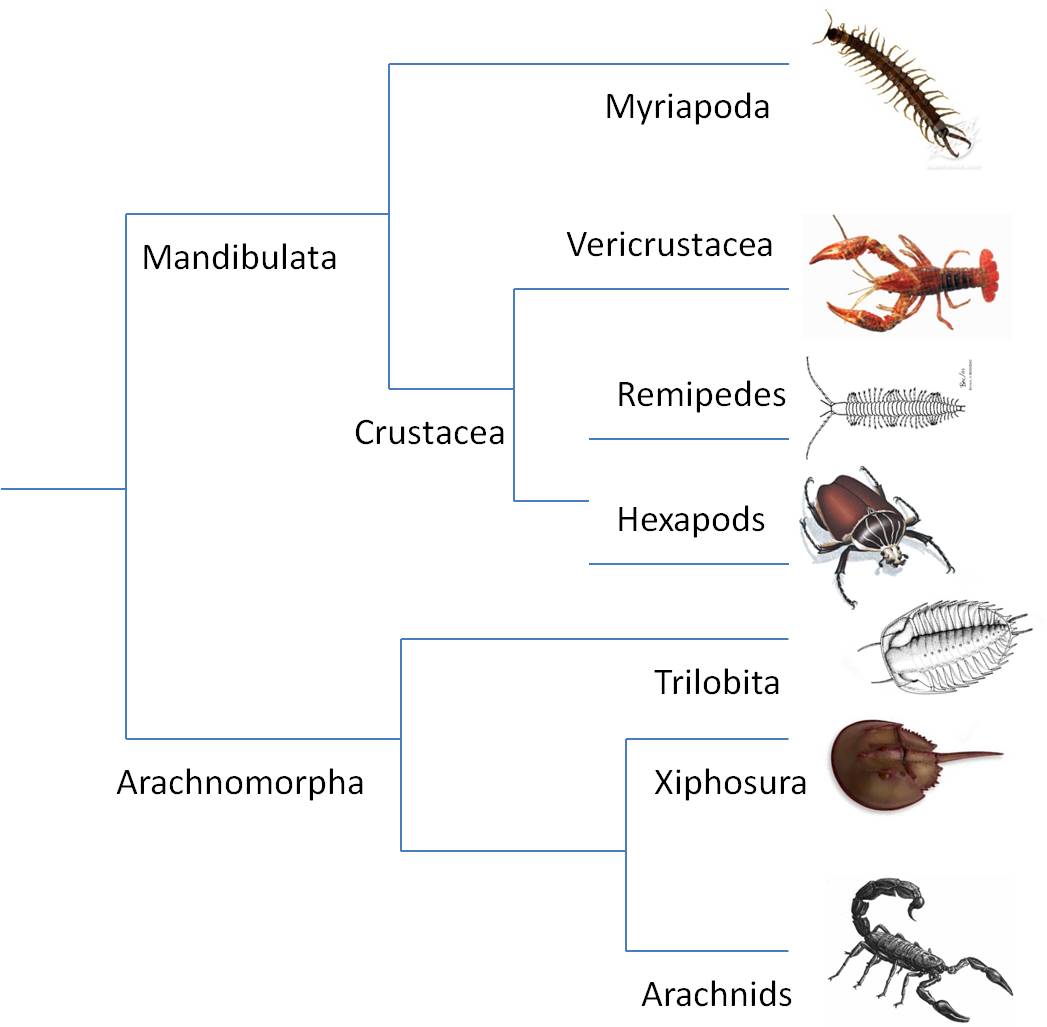 The
arthropods are the most diverse animal group on earth, accounting for 85% of
all animal species. The are an ancient group that came to dominate during the
Cambrian period. The earliest groups were the Chelicerates and Trilobites. The
chelicerates are identified by having only two appendages forward of the mouth
- these are the small, typically pincer-like chelicerae. In spiders, the chelicerae
have evolved into fangs that deliver poison to subdue prey. The other group
of chelicerates are the Horseshoe crabs - an ancient relictual taxon. The other
major clade of arthropods are the mandibulata, which divide into the myriapods
(millipedes and centipedes) and the crustacea. Myriapods are segmented, without
much specialization; each body segment has similar paired appendages used for
walking Centipedes have one pair of legs per segment, and they are predatory;
they have poison glands like spiders and inject their prey to immobilize them.
Millipedes have two apirs of legs per segment. they are slower than centipedes,
and they feed on detritus. In the Eucrustacea, the segments have paired appendages
but they differ in length and function. In addition, they are biramous - having
two roots. One root is a leg, and the other is a gill. Curiously, the insects
are a group derived from aquatic crustaceans. They have flourished and radiated
in terrestrial environments like no other group in the history of our planet.
They have reduced, fused body parts, with appendages limited to head and thoracic
segments. Insect diversity is staggering, and this diversity has interested
ecologist for along time. Why are there so many species of insects? Well, their
diversity is testimony to their adaptability - their exoskeleton means that
they can tolerate dessication. Their small size means that they don't need many
resources to survive. Their power of flight means that they can disperse easily.
This means that they can find resources, but it also means that they are prone
to geographic isolation (and speciation). Finally, they are fecund - most insects
can lay many eggs and thus establish large populations quickly. For all these
reasons and many more, insects are prone to succeed and speciate.
The
arthropods are the most diverse animal group on earth, accounting for 85% of
all animal species. The are an ancient group that came to dominate during the
Cambrian period. The earliest groups were the Chelicerates and Trilobites. The
chelicerates are identified by having only two appendages forward of the mouth
- these are the small, typically pincer-like chelicerae. In spiders, the chelicerae
have evolved into fangs that deliver poison to subdue prey. The other group
of chelicerates are the Horseshoe crabs - an ancient relictual taxon. The other
major clade of arthropods are the mandibulata, which divide into the myriapods
(millipedes and centipedes) and the crustacea. Myriapods are segmented, without
much specialization; each body segment has similar paired appendages used for
walking Centipedes have one pair of legs per segment, and they are predatory;
they have poison glands like spiders and inject their prey to immobilize them.
Millipedes have two apirs of legs per segment. they are slower than centipedes,
and they feed on detritus. In the Eucrustacea, the segments have paired appendages
but they differ in length and function. In addition, they are biramous - having
two roots. One root is a leg, and the other is a gill. Curiously, the insects
are a group derived from aquatic crustaceans. They have flourished and radiated
in terrestrial environments like no other group in the history of our planet.
They have reduced, fused body parts, with appendages limited to head and thoracic
segments. Insect diversity is staggering, and this diversity has interested
ecologist for along time. Why are there so many species of insects? Well, their
diversity is testimony to their adaptability - their exoskeleton means that
they can tolerate dessication. Their small size means that they don't need many
resources to survive. Their power of flight means that they can disperse easily.
This means that they can find resources, but it also means that they are prone
to geographic isolation (and speciation). Finally, they are fecund - most insects
can lay many eggs and thus establish large populations quickly. For all these
reasons and many more, insects are prone to succeed and speciate.
In looking at the mandibulate groups, we see a nice example of an important evolutionary pattern: replication, specialization, and reduction. The myriapods have probably preserved the ancestral body plan within the Arthropoda. Like their probable annelid ancestors, the myriapods are composed of many similar segments. The Eucrustacea represent the next step in the evolution of many body plans - specialization of different body segments for particular functions. So, although every segment of the body of a eucrustacean has paired appendages (like myriapods), those appendages are different lengths and sizes and perform different functions. Appendages in the head are antennae and tiny feeding pincers. Appendages in the thorax are legs and claws (like in lobsters and crabs). Appendages in the abdomen are involved in reproduction (holding eggs, for instance). Next time you have lobster, crab, or shrimp, take a closer look at your meal and notice the paired appendages on each body sement that have become specialized for different functions. In the most derived group of crustaceans - the insects - there is fusion of segments in a given body region and the elimination of redundancy. The abdominal segments have fused into one body region, and the appendages have been lost. The thoracic segments have fused into one body region, and most segments have lost their legs - reducing the redundancy and getting by with 6. Likewise, head segments have fused, and insects have only one pair of antennae (unlike the 2 pairs of eucrustaceans). So, in this one clade, we see the important pattern of segmentation, specialization, and fusion / reduction as a mechanism to produce evolutionary novelty.
Deuterostomes:
j. Phylum Echinodermata: Sea stars, sea urchins, sea cucumbers, sand dollars
 Like
all deuterstomes, the blastopore forms the anus in this phylum. The echinoderms
have an internal skeleton consisting of separate plates that interlock. This
allows them flexibility, but also remarkable rigidity. The body axis of a starfish
is from the bottom, called the oral surface, to the top, called the aboral surface.
So, the legs radiate from the 'waist' of the animal. This symmetry is called
'pentaramous' symmetry. The other interesting adaptiation of echinoderms are
the internal canal system. They have tubes that fill tube feet, causing them
to extend and retract as they fill and deflate. This internal system of canals
is continuous with the environment, with a valve called the madreporite that
regulates water flow from the environment to the canals. The digestive tract
of a starfish is short, from the oral to aboral surface. But the efficiency
is increased by having digestive glands radiate out into the arms or the starfish.
Gonads are also in the limbs.
Like
all deuterstomes, the blastopore forms the anus in this phylum. The echinoderms
have an internal skeleton consisting of separate plates that interlock. This
allows them flexibility, but also remarkable rigidity. The body axis of a starfish
is from the bottom, called the oral surface, to the top, called the aboral surface.
So, the legs radiate from the 'waist' of the animal. This symmetry is called
'pentaramous' symmetry. The other interesting adaptiation of echinoderms are
the internal canal system. They have tubes that fill tube feet, causing them
to extend and retract as they fill and deflate. This internal system of canals
is continuous with the environment, with a valve called the madreporite that
regulates water flow from the environment to the canals. The digestive tract
of a starfish is short, from the oral to aboral surface. But the efficiency
is increased by having digestive glands radiate out into the arms or the starfish.
Gonads are also in the limbs.
k. Phylum Hemichordata: Acorn Worms
The hemichordates are an exclusively marine group. There are interesting because they have two of the four characteristics seen in the chordate: they have pharygeal gills slits and they have a hollow dorsal nerve chord. If you remember from the earthworm dissection, other phyla have ventral nerve chords.There are two major groups of hemichordates, and one group forms protective tubes out of collagen they secrete, and they filter feed with echinoderm-like arms.
l. Phylum Chordata: Tunicates, Cephalochordates, and Vertebrates
All chordates have four characteristics at some point in their development: 1) pharyngeal folds (or gill slits), 2) hollow dorsal nerve tube, 3) notochord, and 4) a post-anal tail. As you might suspect, the similarities among organisms in this phylum are most evident in the larval stages. Cephalochordates like Amphioxus probably maintain the ancestral condition within the phylum. They have swimming larvae, but adults burrow and either feed on detritus or filter feed using their gills as a sieve. The oldest chordate fossils - Pikaia from the Cambrian Period -have a morphology very similar to modern cephalochordates. The Urochordata - the tunicates - have adapted to a more specialized filter-feeding lifestyle. Although their larvae are mobile and similar to Amphioxus, they settle out on a substrate, on their backs, and fold head-to-tail. The pharynx becomes a filtering 'basket'.
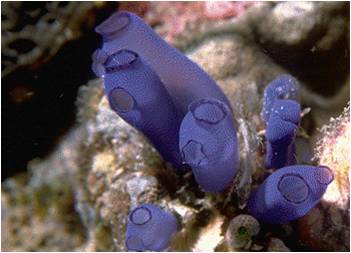 |
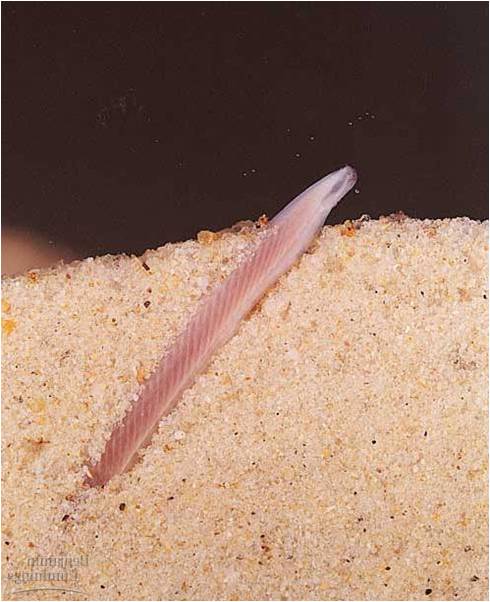 |
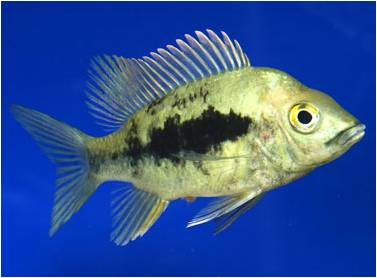 |
Urochordata: Tunicates |
Cephalochordata: Amphioxus |
Vertebrata |
Vertebrates represent the evolutionary lineage that went in the other direction: not towards a sedentary lifestyle but towards an active lifestyle. For the remainder of this unit, we will look at the evolutionary radiations within the vertebrates. We will see a typical pattern throughout this unit. A new group will evolve a novel trait or way of life. This will allow it to use a new environment, or use the environment in a new way. These lifestyles are called "adaptive zones", and they relate to ecological niches. Creation or entry into a new niche or zone means that there is no competition for resources. Under these conditions, almost any strategy using this new novel innovation will work - typically we see a radiation of new species exploiting this new way of life. As this adaptive zone or niche fills with species, they begin to compete. This leads to 'competitive contraction' of diversity, with only a few winners. The same thing happens in any situation where there are potentially limted resources. A new innovation, like the internet, provides opportunities to new businesses. Many flourish initially - like the many browser providers that were present in the '90's. Anyone remember when Netscape was the primary internet provider? Economists call that period the "dot-com boom", when internet companies could get a start just by colonizing this new open marketplace. As companies grew, they began to compete; and there were winners that maintained their position in the niche, and losers that went extinct. The same thing can happen in ecological systems. Competitive contraction can occur within a clade, or as a consequence of a more efficient, new evolutionary novelty arising. Henry Ford's Model T not only put many other car makers out of business, it also puts LOTS of horse-driven carriage companies out of business! So, as a more advanced, efficient group evolves, we sometimes see contraction in the abundance of ancestral forms... just as Darwin predicted.
 The
jawless fishes: The vertebrates are distinguished by having an internal supportive spine that
is subdivided into units called vertebrae. This segmentation of the vertebral
column allows the animal to bend and move with more precision; with some parts
of the body moving while other parts remain stationary. The most primitive members
of this clade are the jawless fishes. The modern representatives are the hagfish
and the lampreys. The hagfish actually lack a subdivided vertebral column, but
they do have a skull surrounding their brain. As such, sometimes the "vertebrata"
are more specifically described as having a skull (to include the hagfish).
Both hagfish and lampreys have immature stages that look almost identical to
cephalochordates, also suggesting their primitive position within this clade.
So, the jawless fish evolve in the Cambrian and radiate in the Ordovician and
Silurian Periods, with many large, detritivorous and filter feeding species
scouring the benthos for food. In more advanced forms, the mouth cavity and
pharynx evolved for feeding, relieving the gills of this filtering function.
These jawless fish probably sucked in small invertebrates by rapidly opening
their mouth.
The
jawless fishes: The vertebrates are distinguished by having an internal supportive spine that
is subdivided into units called vertebrae. This segmentation of the vertebral
column allows the animal to bend and move with more precision; with some parts
of the body moving while other parts remain stationary. The most primitive members
of this clade are the jawless fishes. The modern representatives are the hagfish
and the lampreys. The hagfish actually lack a subdivided vertebral column, but
they do have a skull surrounding their brain. As such, sometimes the "vertebrata"
are more specifically described as having a skull (to include the hagfish).
Both hagfish and lampreys have immature stages that look almost identical to
cephalochordates, also suggesting their primitive position within this clade.
So, the jawless fish evolve in the Cambrian and radiate in the Ordovician and
Silurian Periods, with many large, detritivorous and filter feeding species
scouring the benthos for food. In more advanced forms, the mouth cavity and
pharynx evolved for feeding, relieving the gills of this filtering function.
These jawless fish probably sucked in small invertebrates by rapidly opening
their mouth.
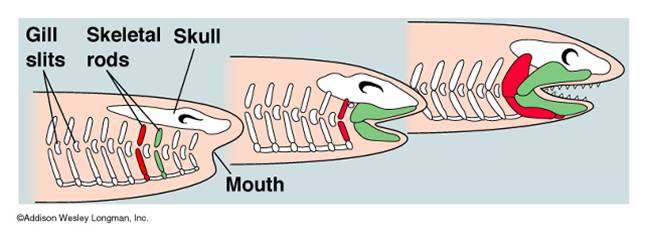 The
Gnathostomes: The Jawed Vertebrates: Jawed fishes evolved
in the Silurian and came to dominate and radiate in the Devonian - the "Age
of Fishes". Jaws evolved from the anterior gill arches, which flex and
became associated withe the mouth. Jaws allowed fish to become more efficient
predators, killing things bigger than could fit in their mouth through suction,
or strong enough to escape the suctioning force. In short, jaws were adaptive
because fish now became mobile, active predators - entering a niche previously
only occupied by large invertebrate predators. The first jawed fish radiation
were the placoderms, symbolized by the frightening Arthrodire predators like Dunkleosteus, with its huge slicing jaw plates. The placoderms were
very heavy, however, and were displaced by more efficient swimmers - the cartilaginous
jawed fishes (Class Chondrichthyes). Modern representatives of this group are
sharks and rays.
The
Gnathostomes: The Jawed Vertebrates: Jawed fishes evolved
in the Silurian and came to dominate and radiate in the Devonian - the "Age
of Fishes". Jaws evolved from the anterior gill arches, which flex and
became associated withe the mouth. Jaws allowed fish to become more efficient
predators, killing things bigger than could fit in their mouth through suction,
or strong enough to escape the suctioning force. In short, jaws were adaptive
because fish now became mobile, active predators - entering a niche previously
only occupied by large invertebrate predators. The first jawed fish radiation
were the placoderms, symbolized by the frightening Arthrodire predators like Dunkleosteus, with its huge slicing jaw plates. The placoderms were
very heavy, however, and were displaced by more efficient swimmers - the cartilaginous
jawed fishes (Class Chondrichthyes). Modern representatives of this group are
sharks and rays.
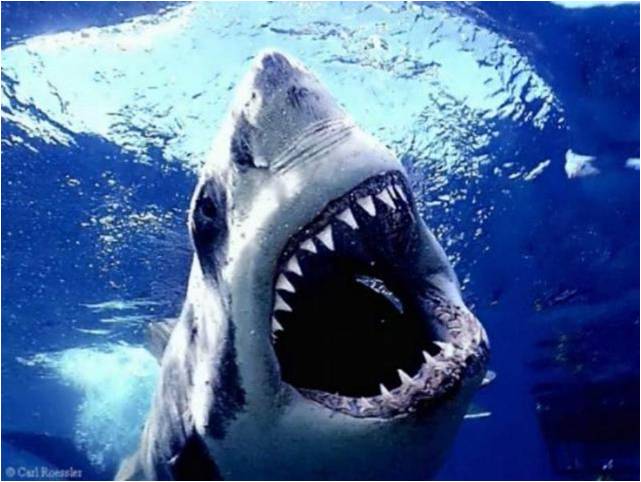 The
Devonian also saw the radiation of the most successful group of fish on earth,
the bony fish (Class Osteichthyes). Unlike cartilage, bone is hollow and light;
it is also more rigid than cartilage, providing more resistance and efficiency
to muscles. The bony fish also had a swim bladder, whcih they used to maintain
neutral bouyancy in the water column. This means that they can maintain position
without swimming; Condrichthyes must swim to maintain vertical position in the
water column - otherwise they sink. These two adaptations of the bony fishes
made them more energetically efficient and faster than the cartilaginous fish,
and the bony fishes have radiated to the point where they represent 40% of all
vertebrate species today (not just fish - vertebrates..!!). Two important clades
evolved within the bony fishes: 1) the ray-finned fishes that came to dominate
the aquatic environments of the planet; and 2) the lob-finned fishes that radiated
into shallow-water environments. The lobe-finned fishes, swimming in shallow,
oxygen-poor waters of the Devonian, gulping air at the surface and pulling themselves
along on their forefins, evolved into the terrestrial tetrapods. Arthropods
had already colonized land, so there was ample food and oxygen for a large terrestrial
predator. As you have seen, the fossil record nicely documents the transition
from fish to these primitive amphibians.
The
Devonian also saw the radiation of the most successful group of fish on earth,
the bony fish (Class Osteichthyes). Unlike cartilage, bone is hollow and light;
it is also more rigid than cartilage, providing more resistance and efficiency
to muscles. The bony fish also had a swim bladder, whcih they used to maintain
neutral bouyancy in the water column. This means that they can maintain position
without swimming; Condrichthyes must swim to maintain vertical position in the
water column - otherwise they sink. These two adaptations of the bony fishes
made them more energetically efficient and faster than the cartilaginous fish,
and the bony fishes have radiated to the point where they represent 40% of all
vertebrate species today (not just fish - vertebrates..!!). Two important clades
evolved within the bony fishes: 1) the ray-finned fishes that came to dominate
the aquatic environments of the planet; and 2) the lob-finned fishes that radiated
into shallow-water environments. The lobe-finned fishes, swimming in shallow,
oxygen-poor waters of the Devonian, gulping air at the surface and pulling themselves
along on their forefins, evolved into the terrestrial tetrapods. Arthropods
had already colonized land, so there was ample food and oxygen for a large terrestrial
predator. As you have seen, the fossil record nicely documents the transition
from fish to these primitive amphibians.
l. Phylum Chordata: Tunicates, Cephalochordates, and Vertebrates
 The
jawless fishes:
The
jawless fishes:
 The
Gnathostomes:
The
Gnathostomes:
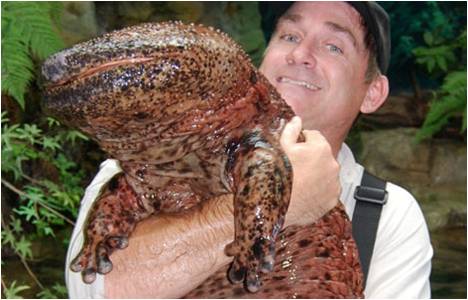 The
Tetrapods: The
tetrapod clade includes all vertebrates descended from the first animals to
walk on land. The radiation of early tetrapods is very impressive; the adaptive
zone of the Carboniferous swamps was very large and well-suited to amphibian
animals reliant on water to lay their eggs. In addition, the huge amount of
biological productivity (lots of photosynthesis and less decompostion, remember?)
led to large populations of herbivorous insects that were eay prey for large
land vertebrates. The Carboniferous could well be called the "Age of Amphibians".
Many groups of early 'amphibians' radiate during this period, collectively called
the 'stem tetrapods'. However, the dry periods of the Permian and Mesozoic were
not optimal for these animals limited to areas near water. Today, three groups
of amphibians remain. The Caecilians are unusual, rare, legless amphibians.
Salamanders are the second group, and the giant Japanese salamander is the largest
living amphibian - reaching six feet in length! The most diverse group is the
Anura - mening "tailless" - the frogs and toads. Most amphibians have
gills or lungs at some point in their life cycle, but many also (or exclusively)
respire through their skin. For this to happen, the gases must diffuse into
a thin film of water, and then move across cell membranes by diffusion. So,
most amphibians need to keep their skin moist to respire; and it also means
that their skin, as an absorptive surface, is also prone to absorb toxins in
the environment. For these reasons, amphibians are particularly sensitive to
pollutants and environmental contaminants. Over the last 50 years, there has
been a dramatic decline in amphibian populations worldwide, probably due to
exposure to human-produced pollution, climate change, and chytrid fungal infections.
It is tough to say which of these variables is 'most' responsible for the decline.
In all likelihood, each factor increases sensitivity to the other two. In any
case, these three factors are having a decimating effect on amphibian populations.
The
Tetrapods: The
tetrapod clade includes all vertebrates descended from the first animals to
walk on land. The radiation of early tetrapods is very impressive; the adaptive
zone of the Carboniferous swamps was very large and well-suited to amphibian
animals reliant on water to lay their eggs. In addition, the huge amount of
biological productivity (lots of photosynthesis and less decompostion, remember?)
led to large populations of herbivorous insects that were eay prey for large
land vertebrates. The Carboniferous could well be called the "Age of Amphibians".
Many groups of early 'amphibians' radiate during this period, collectively called
the 'stem tetrapods'. However, the dry periods of the Permian and Mesozoic were
not optimal for these animals limited to areas near water. Today, three groups
of amphibians remain. The Caecilians are unusual, rare, legless amphibians.
Salamanders are the second group, and the giant Japanese salamander is the largest
living amphibian - reaching six feet in length! The most diverse group is the
Anura - mening "tailless" - the frogs and toads. Most amphibians have
gills or lungs at some point in their life cycle, but many also (or exclusively)
respire through their skin. For this to happen, the gases must diffuse into
a thin film of water, and then move across cell membranes by diffusion. So,
most amphibians need to keep their skin moist to respire; and it also means
that their skin, as an absorptive surface, is also prone to absorb toxins in
the environment. For these reasons, amphibians are particularly sensitive to
pollutants and environmental contaminants. Over the last 50 years, there has
been a dramatic decline in amphibian populations worldwide, probably due to
exposure to human-produced pollution, climate change, and chytrid fungal infections.
It is tough to say which of these variables is 'most' responsible for the decline.
In all likelihood, each factor increases sensitivity to the other two. In any
case, these three factors are having a decimating effect on amphibian populations.
The Amniota: Within the tetrapods, a new type of animal evolved in the Carboniferous; an animal that laid an egg surrounded by a series of membranes and a shell. These layers served to protect the developing embryo and yolk sac from dessication, allowing these species to colonize land further from water and exploit food resources and habitats that amphibians could not reach. This clade of animals is the amniotes, and their evolutionary innovation is the amniotic egg. The primitive condition within this group probably produced a leathery covering, much like turtles. A more rigid, desiccation resistant egg like birds have is probably a derived trait, as is the retention of the egg and live bearing of young, as seen in some snakes, and most mammals. The amniotes radiated during the Permian Period, when the drying of the unified land mass of Pangaea gave them a decided advantage over the ancestral, amphibious tetrapods. Three groups evolved at this time, distinguished by their skull morphology.
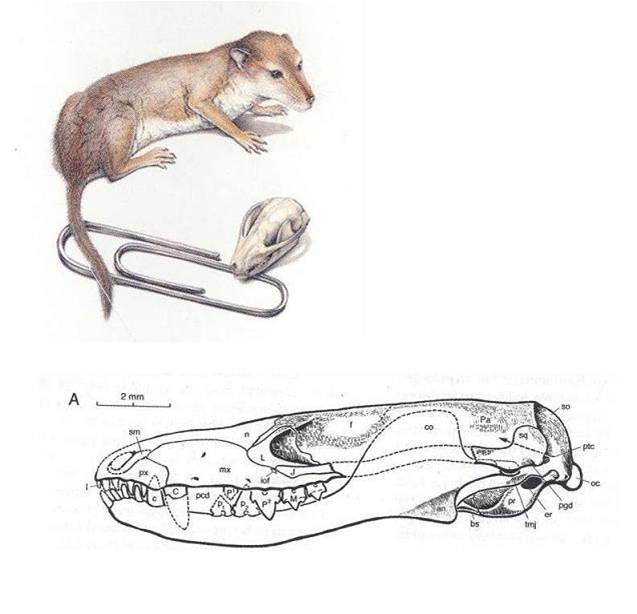 The
Synapsids and the Mammals: The first group to dominate
were the synapsids. They dominated during the Permian, and were represented
by the great "sail-finned" Pelycosaurs and the Therapsid lineages
(the Gorgonopsians, the Dicynodonts, and the Cynodonts). The synapsid lineage
that is alive today are the Mammals. The transition from ancestral to derive
synapsids is well preserved in the fossil record, documenting the evolution
of the inner ear from the ancestral jaw bones, and the evolution of complex
and specialized dentition. The first true mammals are the Morganucodonts that
evolved in the Jurassic Period of the Mesozoic, about 200 mya. Ancestral synapsids
were large carnivores that dominated the landscape; a niche that would be filled
by the diapsid dinosaurs during the Mesozoic. The mammals were small, noctural
insectivores and scavengers. They radiated into these niches in the Jurassic,
perhaps because their endothermy allowed them to use the cool night more effectively
and under cover of darkness from larger predators. The surviving lineage of
this radiation are the three species of monotremes alive today: the platypus
and two species of echidna. These mammals lay eggs. Their offspring hatch, and
then nuzzle the belly of their mothers. Their mothers have sweat glands that
have evolved to produce a nutrient rich milk - they are mammary glands. However,
even the modern representatives lack nipples on these glands - so they "sweat"
milk onto their belly and the the hatchlings lick it up. Placental and marsupial
mammals evolved later, in the Cretaceous Period. Marsupials do not lay eggs;
they give live birth to a very small, embryonic newborn. The newborn climbs
from the genital opening to the pouch - a flap of skin covering the nipples
of the mammary glands. The embryo attaches to a nipple and feeds nearly continuously,
completing development in the pouch. This allows the mother to carry the embryo
with her for a longer period; there are no eggs that must be left periodically
for the mother to feed. The last group of mammals, the placentals, also retain
the embryo and give live birth. However, they retain the embryo much longer,
often until the offspring is capable of independent activity. The efficient
feeding of the embryo is facilitated by the placenta - which allows nutrients
in the bloodstream of the mother to pass directly into the bloodstream of the
offspring. This is far more efficient, energetically, than the mother turning
the nutrients into milk, that must be consumed and digested by the offspring.
So, placental mammals can develop more rapidly than marsupials. Some placentals
produce offspring that can walk immediately; these are precocial young. Other
species, like cats and humans, produce offspring that still need considerable
parental care. These offspring are called altricial.
The
Synapsids and the Mammals: The first group to dominate
were the synapsids. They dominated during the Permian, and were represented
by the great "sail-finned" Pelycosaurs and the Therapsid lineages
(the Gorgonopsians, the Dicynodonts, and the Cynodonts). The synapsid lineage
that is alive today are the Mammals. The transition from ancestral to derive
synapsids is well preserved in the fossil record, documenting the evolution
of the inner ear from the ancestral jaw bones, and the evolution of complex
and specialized dentition. The first true mammals are the Morganucodonts that
evolved in the Jurassic Period of the Mesozoic, about 200 mya. Ancestral synapsids
were large carnivores that dominated the landscape; a niche that would be filled
by the diapsid dinosaurs during the Mesozoic. The mammals were small, noctural
insectivores and scavengers. They radiated into these niches in the Jurassic,
perhaps because their endothermy allowed them to use the cool night more effectively
and under cover of darkness from larger predators. The surviving lineage of
this radiation are the three species of monotremes alive today: the platypus
and two species of echidna. These mammals lay eggs. Their offspring hatch, and
then nuzzle the belly of their mothers. Their mothers have sweat glands that
have evolved to produce a nutrient rich milk - they are mammary glands. However,
even the modern representatives lack nipples on these glands - so they "sweat"
milk onto their belly and the the hatchlings lick it up. Placental and marsupial
mammals evolved later, in the Cretaceous Period. Marsupials do not lay eggs;
they give live birth to a very small, embryonic newborn. The newborn climbs
from the genital opening to the pouch - a flap of skin covering the nipples
of the mammary glands. The embryo attaches to a nipple and feeds nearly continuously,
completing development in the pouch. This allows the mother to carry the embryo
with her for a longer period; there are no eggs that must be left periodically
for the mother to feed. The last group of mammals, the placentals, also retain
the embryo and give live birth. However, they retain the embryo much longer,
often until the offspring is capable of independent activity. The efficient
feeding of the embryo is facilitated by the placenta - which allows nutrients
in the bloodstream of the mother to pass directly into the bloodstream of the
offspring. This is far more efficient, energetically, than the mother turning
the nutrients into milk, that must be consumed and digested by the offspring.
So, placental mammals can develop more rapidly than marsupials. Some placentals
produce offspring that can walk immediately; these are precocial young. Other
species, like cats and humans, produce offspring that still need considerable
parental care. These offspring are called altricial.
The Diapsids: The other major group of amniotes are the diapsids. They radiated into two major groups, the lepidosaurs that walked with their legs splayed out and the archosaurs that walked with their legs underneath.
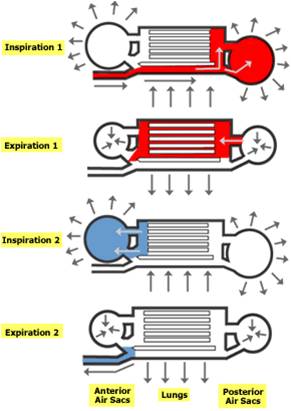 The
archosaurs would dominate during the Mesozoic Era, with the great
radations of the Crocodylomorphs, Pterosaurs, and Dinosaurs. Two groups of Archosaurs
persists today - the crocodilians (caimen, gavials, alligators, and crocodiles),
and the birds. Although several groups of dinosaurs evolved feathers - probably
first for attracting mates or communicating, and then for insulation - only
in the birds did these feathers evolve for powered flight. Associated shared
derived characters are light, hollow, fused bones, the fusion of digits in the
forelimbss, a keeled sternum for anchoring large breast muscles used for flight,
and a 'wishbone' - a union of the two clavicles that acts like a spring during
the flight stroke. The loss of teeth is also a derived trait in this group,
as is the evolution of an interesting respiratory system of air sacs. Birds
have a one way lung. Air that's inhaled goes to a posterior air sac. On the
first exhalation, air is moved forward through the lung. The second inhalation
refills the posterior air sac, and the next exhalation pulls deoxygenated air
forward into the anterior air sac and out of the animal. This modification,
like a one-way digestive tract, improves the efficiency of the organ. Now, the
air in the lung is always oxygenated; it is not mixed with deoxygenated air
like in the sac-like lungs of other animals. It's not surprizing that birds
would evolve this system, as the metabolic demands of flight are much more significant
than other forms of locomotion.
The
archosaurs would dominate during the Mesozoic Era, with the great
radations of the Crocodylomorphs, Pterosaurs, and Dinosaurs. Two groups of Archosaurs
persists today - the crocodilians (caimen, gavials, alligators, and crocodiles),
and the birds. Although several groups of dinosaurs evolved feathers - probably
first for attracting mates or communicating, and then for insulation - only
in the birds did these feathers evolve for powered flight. Associated shared
derived characters are light, hollow, fused bones, the fusion of digits in the
forelimbss, a keeled sternum for anchoring large breast muscles used for flight,
and a 'wishbone' - a union of the two clavicles that acts like a spring during
the flight stroke. The loss of teeth is also a derived trait in this group,
as is the evolution of an interesting respiratory system of air sacs. Birds
have a one way lung. Air that's inhaled goes to a posterior air sac. On the
first exhalation, air is moved forward through the lung. The second inhalation
refills the posterior air sac, and the next exhalation pulls deoxygenated air
forward into the anterior air sac and out of the animal. This modification,
like a one-way digestive tract, improves the efficiency of the organ. Now, the
air in the lung is always oxygenated; it is not mixed with deoxygenated air
like in the sac-like lungs of other animals. It's not surprizing that birds
would evolve this system, as the metabolic demands of flight are much more significant
than other forms of locomotion.
The Lepidosaurs also radiated during the Mesozoic, but did not do so as dramatically as the Archosaurs. Today, the surviving representatives are the Squamata (lizards and the derived snakes) and their sister group, the Sphenodonts with two surviving relict species of Tuatara native to New Zealand. The tuatara maintains the most primitive amniote characteristics, and so is very valuable in studying the phylogeny of diapsid reptiles. The derived squamates, the modern lizards and snakes, have scales, a double hinged jaw (particularly important in snakes), and a hinge on the top of their skull.
That concludes a look at the phyla of animals. Next we will take a brief look at the evolutionary history of our own small twig on the mammalian limb.
Study Questions:
1. What are the stages of animal embryogenesis?
2. How do sponges feed and distribute nutrients through their body?
3. How do cnidarians feed and distribute nutrients through their body?
4. Why is bilateral symmetry, rather than radial symmetry, associated with "cephalization" in motile organisms?
5. What is the benefit of a highly convoluted gut in flatworms?
6. What is the advantage of a digestive tract, compared to a gut sac?
7. Why was segmentation - the replication of body units - such an important evolutionary innovation?
8. Why have clams "lost their head"?
9. What important evolutionary pattern do we see in the mandibulate groups - going from myriapods to eucrustaceans to insects?
10. List the characteristics of the Chordates
11. Describe the body plan of a starfish.
12. How did ancestral jawless fishes feed?
13. How did the jaw evolve and what benefit did it provide?
14. What were the probable benefits of colonizing land?
15. What is an amniotic egg and what benefit does it provide? Why did amniotes radiate in the Permian?
16. Describe the reproductive differences among the monotremes, marsupials, and placentals. What advantages were there for marsupial and then placental reproductive strategies?
17. Explain how a bird's respiratory system is more efficient than a mammal's.